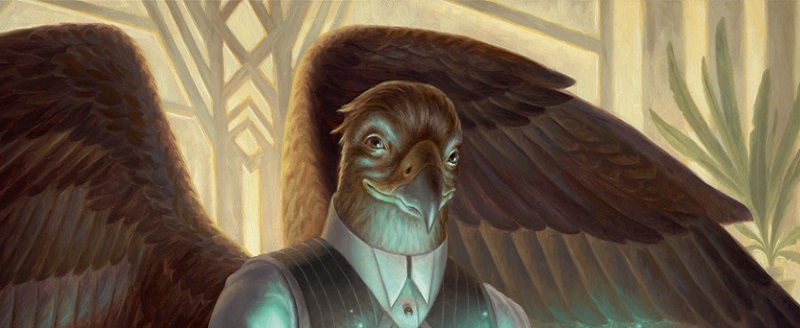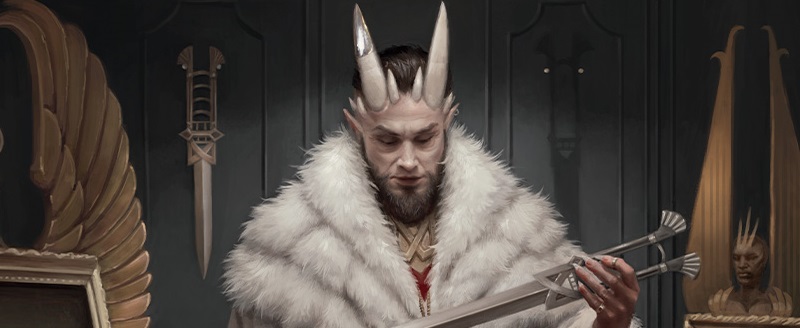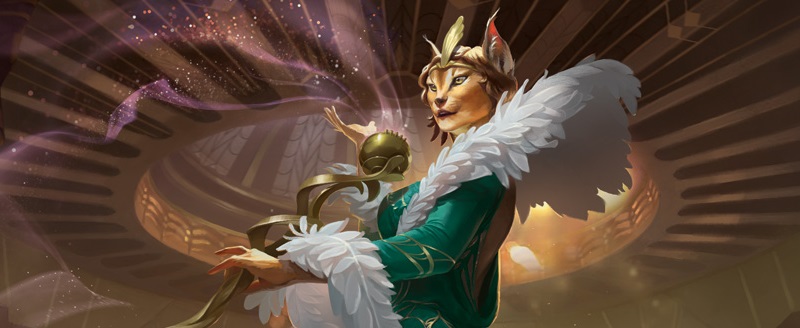Introduction
Welcome to our Draft Primer series for Streets of New Capenna. Today we are taking a detailed look at the limited archetypes, exploring the possibilities on offer in Magic the Gathering’s latest set.
New Capenna's mobster theme brings us five new, criminal families vying for control of the city. Each of them has its own unique mechanic, new for the set, so check out our Draft Primer: Limited Mechanics article first if you need to brush up on those. Otherwise, let’s get into it.
Contents
1. Set Overview 2. Allied Color Pairs - Azorius (White-Blue) - Selesnya (White-Green) - Dimir (Blue-Black) - Rakdos (Black-Red) - Gruul (Red-Green) 3. Three Color Shards - Obscura (White-Blue-Black) - Brokers (White-Blue-Green) - Cabaretti (White-Green-Red) - Maestros (Blue-Black-Red) - Riveteers (Black-Red-Green)Set Overview
The first set in some time to feature official support for three color decks, Streets of New Capenna brings us five new flavorful families. Each of these families exists in a three color shard, as shown in the images below.


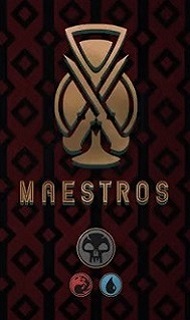
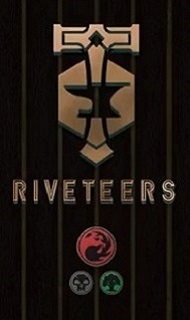

Whilst many drafters will be itching to play with these three color decks, it’s important to note that five two-color archetypes are also well supported. These are the allied color pairs, comprising Azorius, Selesnya, Rakdos, Dimir and Gruul.
These five allied color pairs will form the backbone of almost every deck in the format. This is true since, not only do they constitute half of the archetypes, but they also form the basis of the three color shards. By this we mean that each shard can be formed by starting with an allied color pair and adding a third color.
For example Brokers can be formed by starting with Selesnya and splashing blue or by starting with Azorius and splashing green. It would be considerably more difficult to build a Brokers deck by starting in Simic (an unsupported color pair) and then splashing white. As such, when drafting it's a solid approach to consolidate first into an allied color pair before later branching into a third color if applicable.
Finally, before we get into the archetypes please note that, whilst the allied color pairs have tightly defined themes, the shards have themes which are much broader. This means that there will be several micro archetypes within each shard. As such, a drafter may have success with a variety of different decks within each three color family.
Azorius (White-Blue)
The theme for Azorius is counters matter. The color pair’s first signpost uncommon, Metropolis Angel, leaves little doubt in our minds about this. Lacking a counter itself, this card needs a little support to get going. However a player who gets a counter on the Angel, or on another evasive threat, will find the card advantage quickly snowballing.
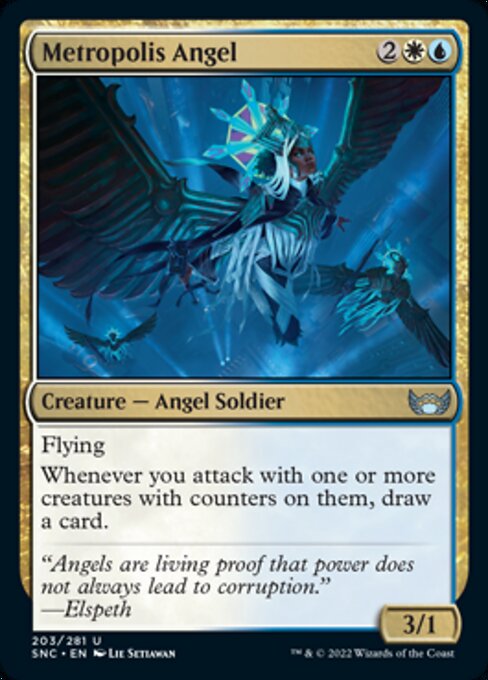
The second signpost uncommon for Azorius, Exotic Pets, further pushes the counters matter theme. Creating two 1/1 bodies at instant speed is nice for three mana, especially as they can’t be blocked. Being able to clone counters however, makes this card really pushed, provided you have enough supporting pieces in your deck, that is.
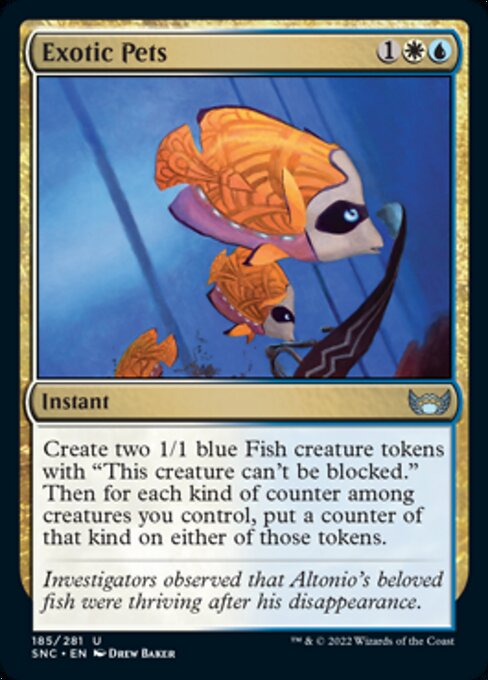
Next up, at common, we see Celestial Regulator. A 2/3 flying body for three mana is already super solid, making the tap down ability icing on the cake. Great when ahead and capable of buying some time when behind, this card is clearly at its best in a deck with plenty of counters.
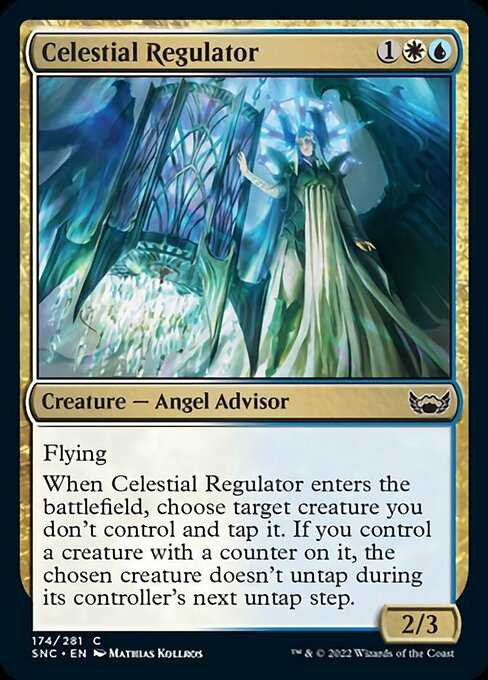
With three super solid gold cards offering payoffs for the counters matter theme, it’s prudent to question where the enablers for this deck are. Fortunately for Azorius, both the connive mechanic and shield counters are capable of switching on our payoffs. With blue and white being the central colors for these two enablers, those drafting Azorius shouldn’t struggle to get counters on the board.
Selesnya (White-Green)
The theme for Selesnya is citizens, that is the creature type citizen. We see this quite clearly in Darling of the Masses which not only creates citizens, when it attacks, but buffs the power of other citizens too. Throw in the fact that it’s a citizen itself and the theme is plain to see.

The color pair's other signpost uncommon is Ceremonial Groundbreaker. Whilst this equipment bestows +2/+1, as well as trample, it costs a mighty three mana to equip, unless of course you are equipping a citizen. Turning an army of 1/1 creatures into relevant threats seems like a nice payoff for going wide, especially when it can be done on the cheap.
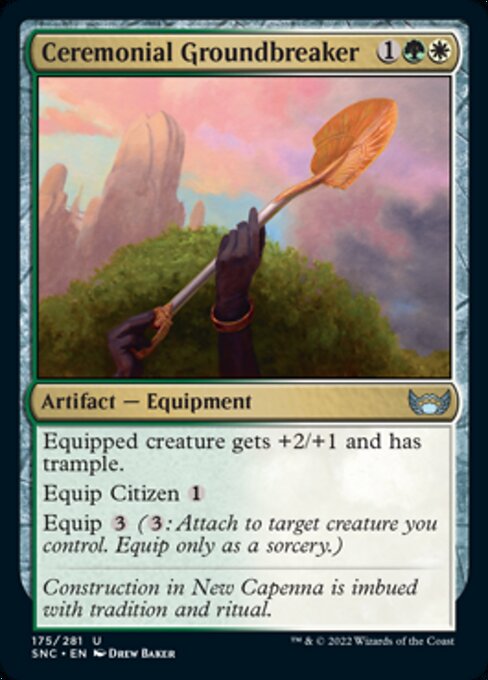
Selesnya’s common two drop, Civil Servant, will slot nicely into the archetype. Capable of attacking as a 3/3 lifelink, this card also emphasizes the fact that, in order to excel in this archetype, it's important to have extra citizens on the board.

Dimir (Blue-Black)
Loosely speaking, Dimir’s theme is the graveyard. To be more specific, the color pair cares about having five or more mana values among cards in your graveyard.
Dimir’s first signpost uncommon, Tainted Indulgence, makes this theme pretty clear. Whilst drawing two and discarding one is unexciting for two mana, the discard helps fill up your graveyard and, once the condition is switched on, simply drawing two is clearly great.
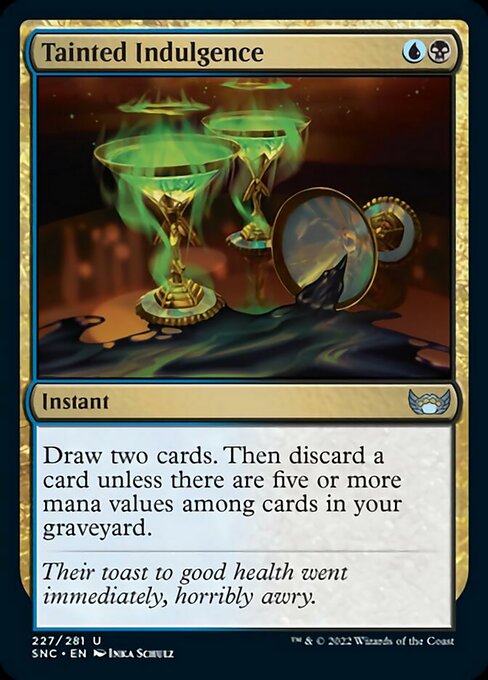
Dimir’s next signpost Syndicate Infiltrator is a Phantom Monster with serious upside, becoming a 5/5 flier once the condition is met. Likewise Aven Heartstabber, at rare, gets a similar buff, with the added advantage of some mill and card draw when it dies.
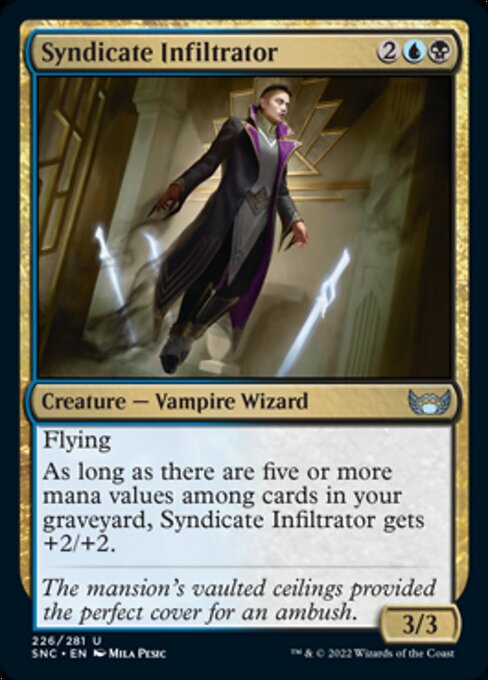

Offering the mill up front, Snooping Newsie, is a reasonable way to start filling up your graveyard. Cards like this, which offer enablers for a strategy as well as a payoff, are typically solid, especially when they also affect the board. Additionally, this card has the benefit of providing a 2/2 on turn two as well as a more relevant creature later in the game.
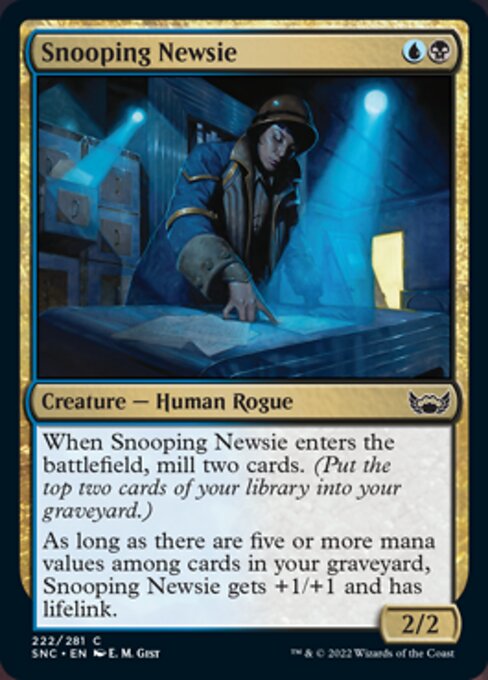
Rakdos (Black-Red)
Not a new theme this time around for Rakdos, sacrifice is the name of the game. With black’s casualty cards acting as sacrifice outlets and red’s blitz cards providing the fodder, it's a marriage made in heaven (or perhaps hell). Either way, this color pair looks to have some great combo potential inside an otherwise aggressive shell.
The first signpost uncommon is Forge Boss. This threatening 3/4 can put a fast clock on your opponent, dealing 2 damage when you sacrifice a creature. With the right support, a card like this can be a brutal engine your opponent will be forced to deal with, or suffer the consequences.
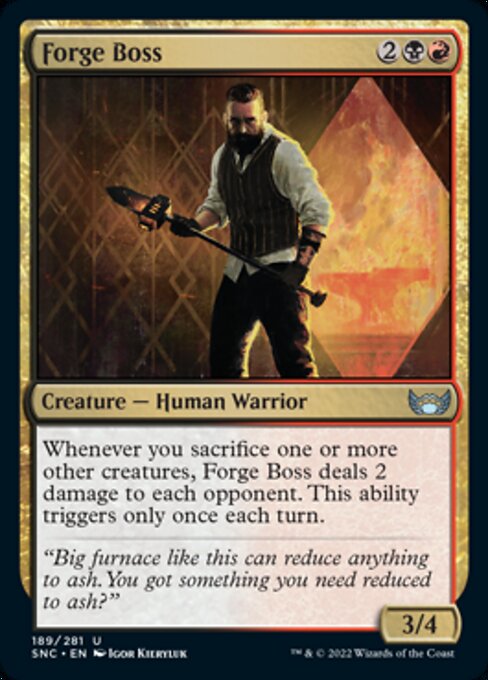
Next up is Fatal Grudge. Requiring a little set-up, this is one of those cards that could let you down in certain situations. That said, the prospect of exchanging your own worst creature for your opponents is reasonable enough and the three magic words, draw a card, go a long way to sweeten the pot.
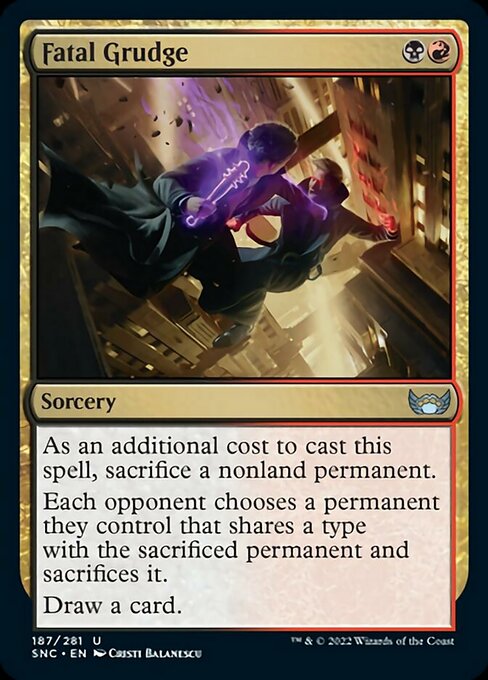
At common we see Body Dropper. Gaining a +1/+1 counter whenever you sacrifice another creature, this two mana 2/2 seems very powerful. Between menace and the threat of its activated ability, this card will make combat a nightmare for your opponent.
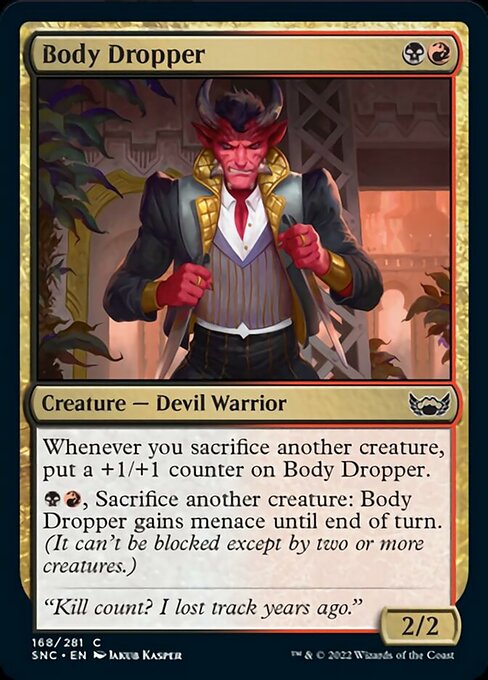
With so many sacrifice outlets in the set, thanks to casualty, we are happy to see that this set's Act of Treason effect isn't available at common. Likely to be a total powerhouse in this deck, Involuntary Employment even provides a treasure to help pay the cost of sacrificing the stolen creature.

Gruul (Red-Green)
Gruul’s theme is an unusual one, treasure matters. Looking at the first signpost uncommon we find Security Rhox. A beefy 5/4 for four mana if cast the regular way, this card gets considerably discounted if you choose to pay with treasure instead.

If that wasn’t clear enough, the second signpost uncommon, Stimulus Package really hammers home this theme. Allowing us to convert treasure tokens to 1/1 citizens at instant speed, this four mana enchantment begs the question - where will we ever find enough treasure to make this worthwhile? One answer to that could be found in Black Market Tycoon at rare. Whilst this two drop will punish you fiercely for having a stockpile of treasure, it’s capable of creating them at instant speed.
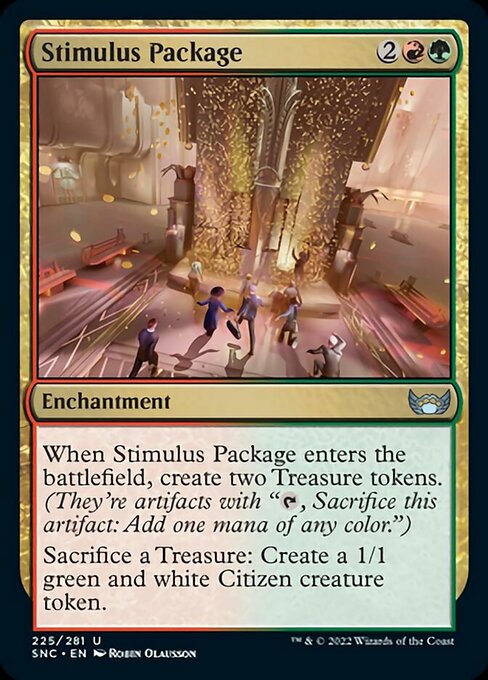

At lower rarity, Gruul’s multicolor common, Jetmir's Fixer, is a fine looking two drop. The pump ability will make life difficult for your opponent during combat but the option to put +1/+1 counters on this ensures it will stay relevant late into the game.
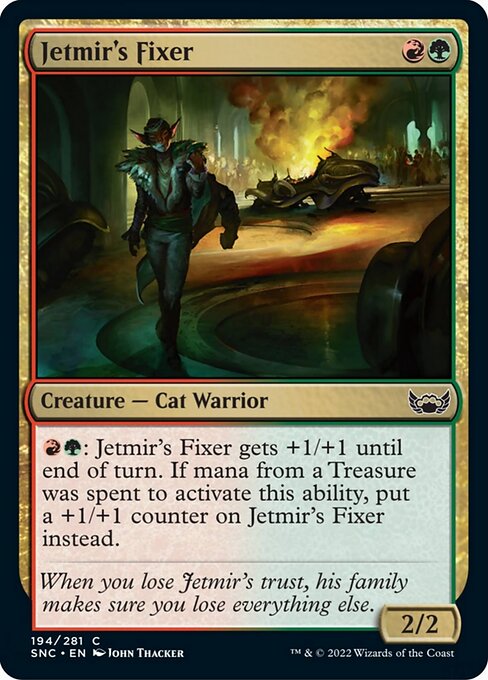
Obscura (White-Blue-Black)
Obscura’s theme is control and, with access to a wealth of card selection, spot removal and even board wipes, the shard is well positioned to play that role. Whilst control decks in limited, rarely play out like their constructed cousins, Obscura would still love to slow the game down and trade off pieces before pulling ahead with card advantage or bombs.
The shard's first signpost uncommon, Nimble Larcenist, provides a flying threat whilst potentially snagging a card from your opponent's hand. Yes, this effect will blank some percentage of the time, but the 2/1 flying body isn’t embarrassing and the chance of a two for one is too good to pass up.
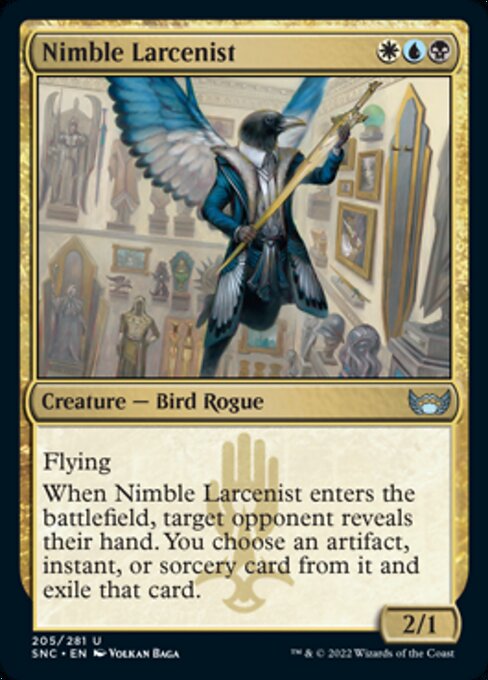
Obsura’s legendary uncommon, Queza, Augur of Agonies is a 3/4 for four mana. Whilst not an impressive body, the drain ability highlights exactly what Obscura wants to be doing, sitting behind a line of defensive creatures and drawing cards, happy to win a long game.
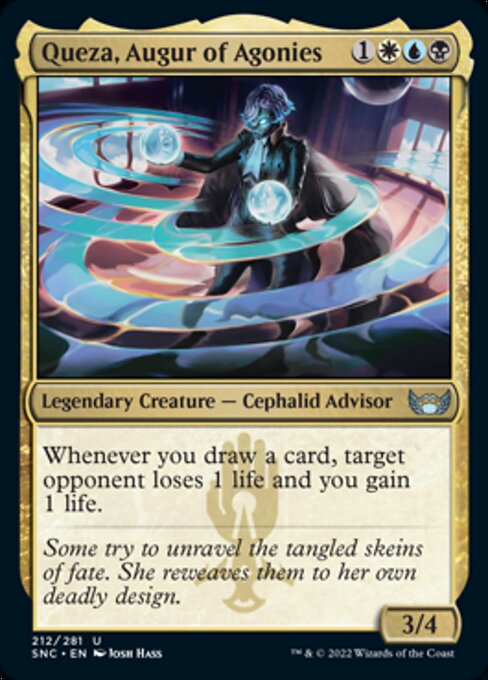
As with the other cards in this cycle, Obscura Charm offers flexibility through power. With a creature in the graveyard ready to reanimate, you can hold this up, prepared to counter a spell or destroy a creature as needed, without risking burning your mana.
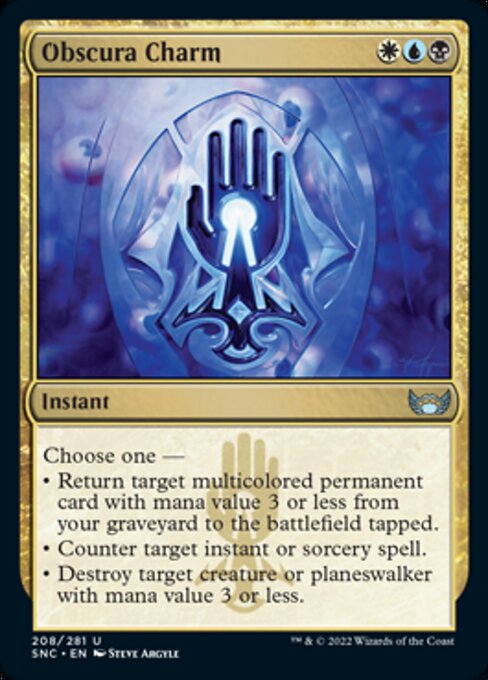
With flash, lifelink and the ability to return a spell to its owner's hand, Obscura Interceptor is an excellent control card at rare. Due to the myriad of possible outcomes, this card will really reward players who can plan ahead and time the interceptors' entry perfectly.
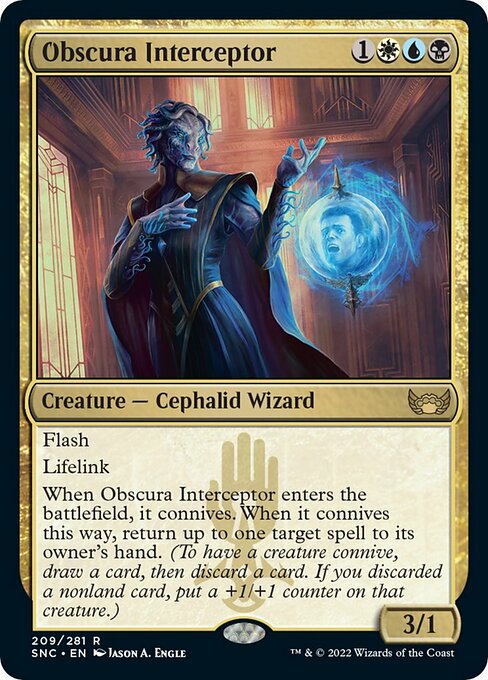
Brokers (White-Blue-Green)
The theme for the Brokers isn’t especially well defined. Merging those of Azorius (counters matter) and Selesnya (citizens) leaves us with an archetype potentially interested in both of these topics but without a striking new direction. Fittingly their signpost uncommon, Disciplined Duelist has both the citizen creature type and shows off a shield counter. With first strike as well as the one time indestructible effect, the duelist is going to be tough to deal with in combat.
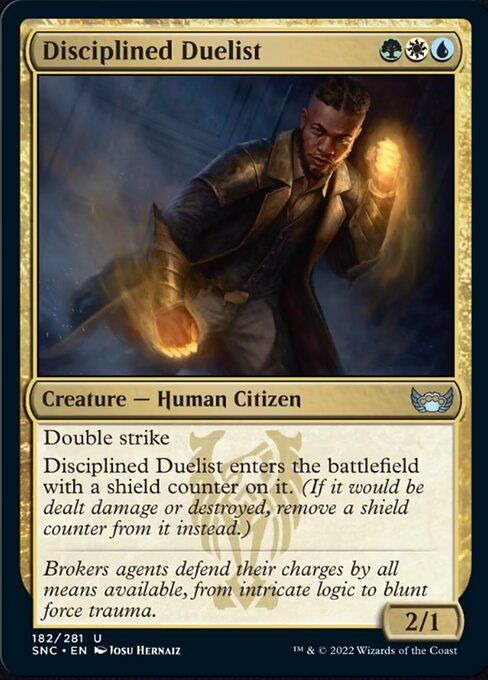
The Brokers’ uncommon legend, Lagrella, the Magpie, is an unusual card. Clearly worded for commander players, her ETB allows you to exile an opponent’s creature, as well as one of your own, until she leaves the battlefield. It seems obvious that exiling an opponent’s creature is beneficial but what about our own? Most of the time we won’t want to use this ability, however in some cases, for instance when our creature has an ETB, this might have some utility and of course the +1/+1 counters are nice.
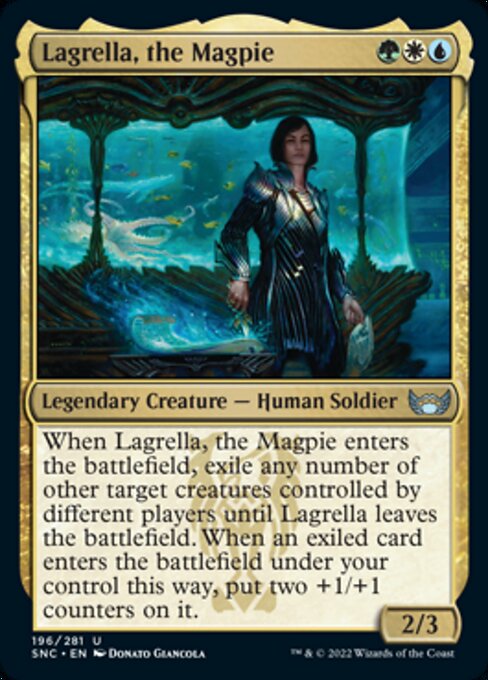
A nice addition to any deck that can cast it, Brokers Charm doesn’t exactly point to a particular theme either. Whilst each mode of this spell is solid, none of them are mind blowing at three mana, yet the strength of this card lies in its flexibility.
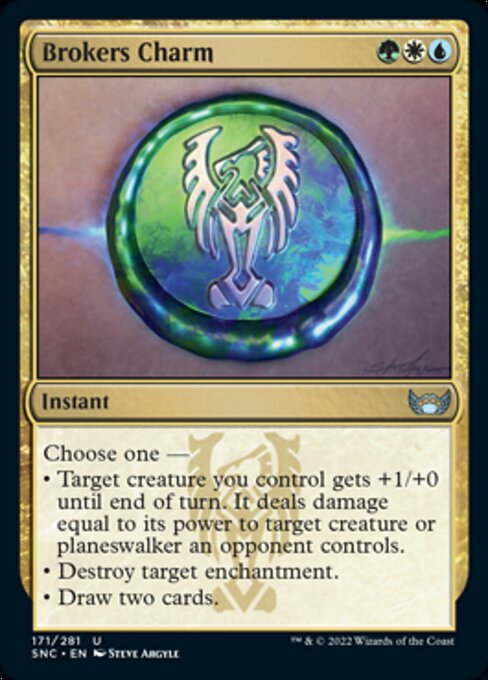
Moving on to Brokers Ascendancy we finally find a card that feels like a signpost. Giving a +1/+1 counter to each of our creatures feels better and better the wider our board becomes. Part of a cycle, one for each family, this card is powerful and could clearly get out of hand.
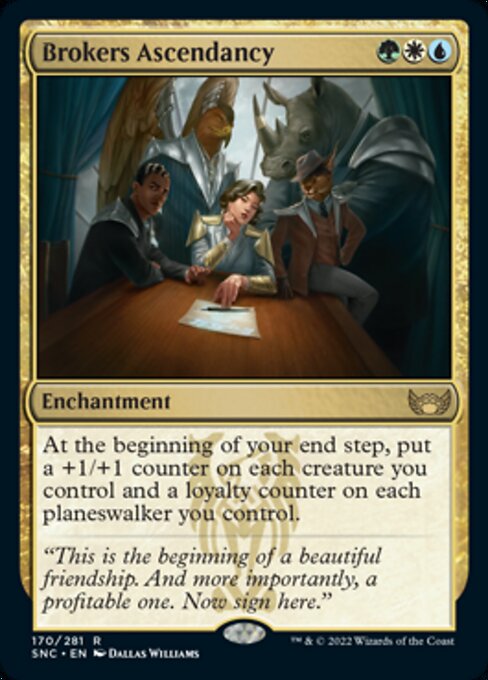
The leader of the Brokers, Falco Spara, Pactweaver, is a build around of sorts as it rewards you for having an excess of counters at your disposal. That said counters are fairly well baked into the archetype so you shouldn’t have to work too much to make this card a legitimate cardraw engine.
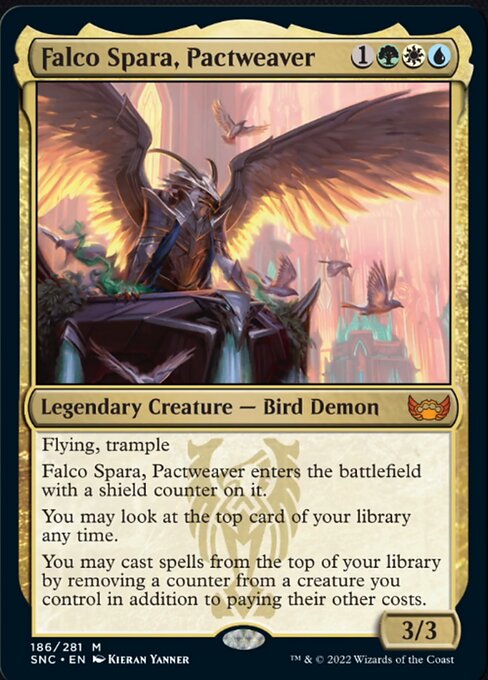
Cabaretti (White-Green-Red)
Loosely speaking Cabaretti’s theme is creatures, masses of them. Cabaretti cards give powerful bonuses to those who can pack as many creatures as possible onto the board and into their library.
Brazen Upstart, Cabaretti’s signpost uncommon shows the importance of creatures in this archetype. With vigilance and four power, this will present a quandary for opponents who will be reluctant to trade off, for fear of landing a bomb in your lap.
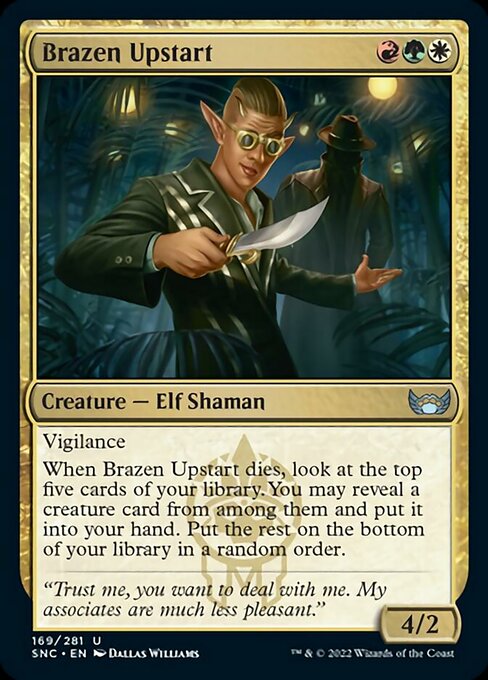
Rocco, Cabaretti Caterer, the family's uncommon legend, offers a powerful search up ability. Scaling well with the game, this card clearly gets better the more mana you can sink into it. Knowledge of your deck will come in very handy here, as the mana cost must be paid upfront, before you search the creature up.
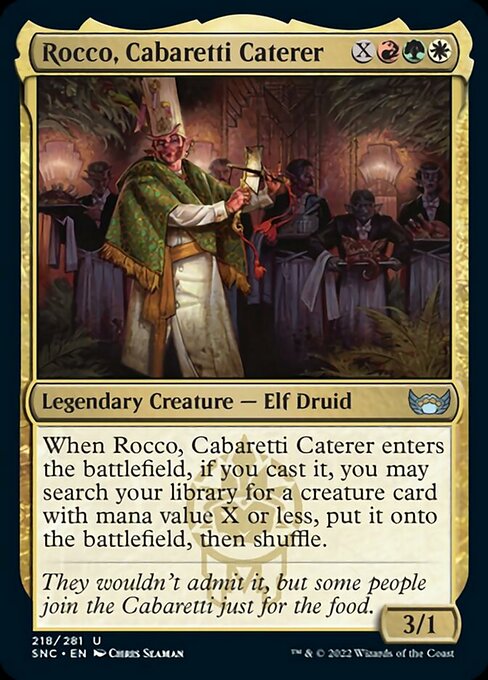
Cabaretti Ascendency is another card which points towards creature density being important in this archetype. Although rare, and therefore perhaps less of a signpost, this card suggests that packing your deck with creatures is the right way to go.
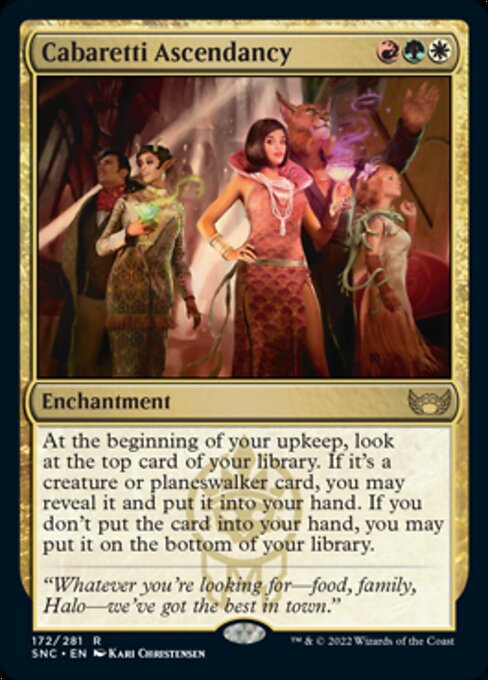
It’s Cabaretti Charm, however, that really pushes the idea of a go-wide theme in this shard. Every mode of this instant either benefits from a wide board or helps to create one.
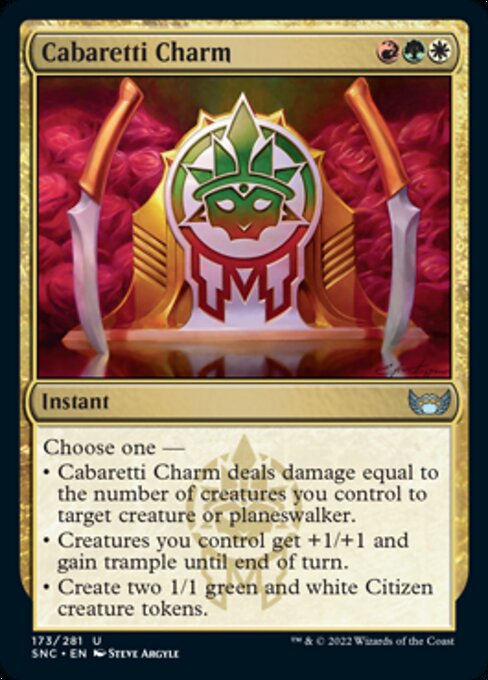
Finally, looking to the mob boss for guidance, we find that Jetmir, Nexus of Revels, is a clear advocate of a wide board. A solid body in a vacuum, this card gives increasingly more powerful bonuses the wider your board becomes.
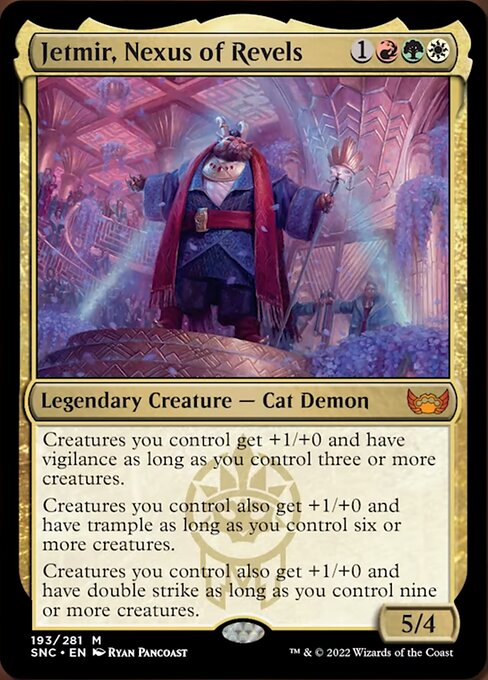
Maestros (Blue-Black-Red)
The theme for the Maestros, loosely speaking, is the graveyard. More specifically, this shard wants you to have a heavily stocked yard, looking to gain value from recasting spells or exiling creature cards for a bonus.
The signpost uncommon for the Maestros, Corpse Appraiser highlights how important it is for this shard to have a well stocked graveyard. A player who meets the condition is rewarded with card selection and can enjoy their yard being filled up further.
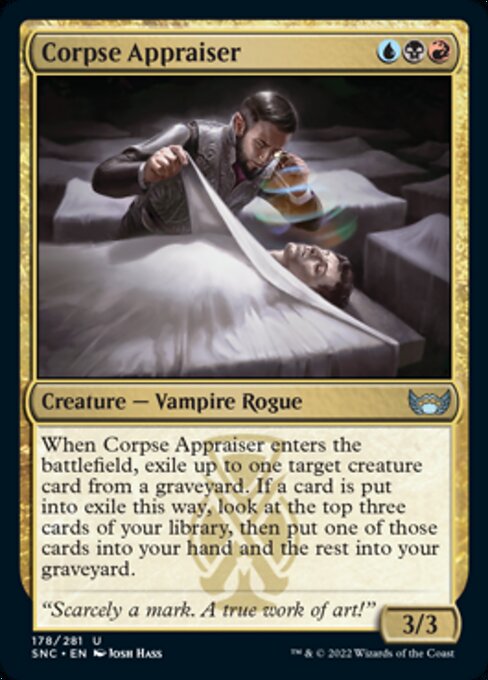
Whilst the Corpse Appraiser requires a creature card in the graveyard, Cormela, Glamour Thief is looking for an instant or sorcery, in order to generate further value when she dies. With haste and the ability to tap for multicolored mana, she can act as an accelerant, allowing two spells to be cast in one turn, as well as being used later in the game to ramp into more powerful spells.

Maestros Ascendancy, on the other hand, is a card which asks the player to build in several directions. In order to be powerful, this card will require a surplus of instants or sorceries in the graveyard as well as an excess of creatures to sacrifice. This card, whilst potentially powerful in the right situation, will certainly require some expert deck building to make it tick.
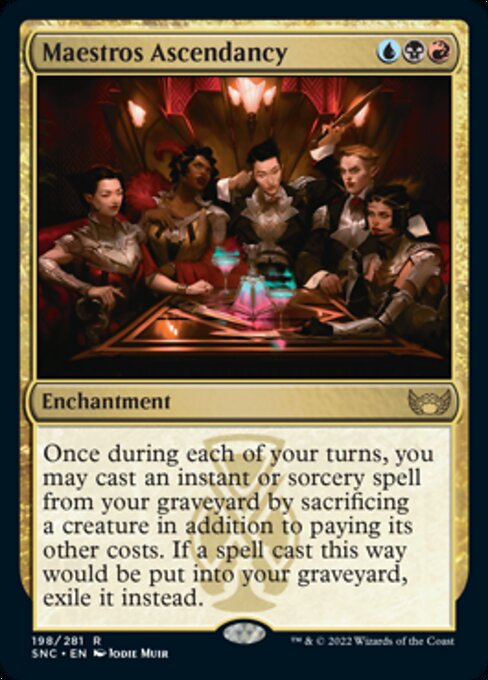
The Maestro’s Charm provides a way to stock your graveyard with its first mode, whilst ensuring you draw into some gas. Whilst the drain effect of the middle mode is less powerful, there certainly will be spots where it swings a game and the final mode will take care of almost any threat.
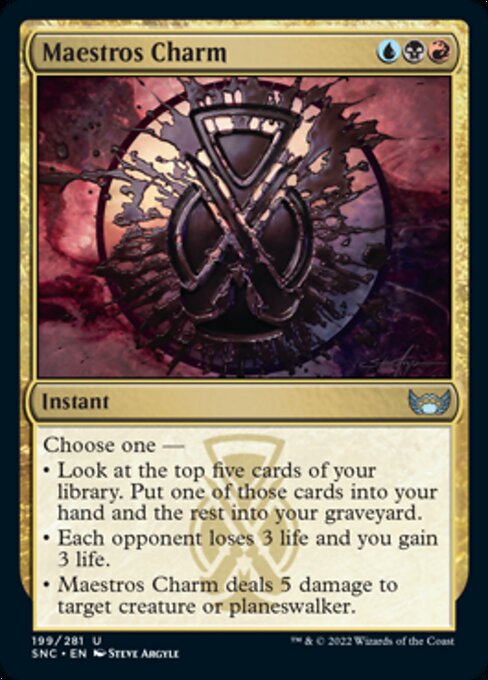
A powerful and flexible sweeper, Hostile Takeover, ensures you'll be able to deal with your opponent’s largest threat whilst also preventing one of your own small creatures from succumbing to the wrath. An excellent addition to any deck that can reliably cast it, this is the type of card that turns around losing games and puts the nail in the coffin when you are ahead.

Riveteers (Black-Red-Green)
Lacking a super cohesive theme, the Riveteers are the most aggressive of the three color shards. Many of their gold cards are either excellent at pushing damage or reward you for doing so. With a wealth of cards to choose from over the three colors, their theme could be best described as aggro value.
The Riveteers’ signpost uncommon the Crew Captain is a 4/2 with haste and indestructible, the turn it enters the battlefield. Not exactly versatile, this card is hard hitting however, especially if your opponent is already on the back foot when you cast it.
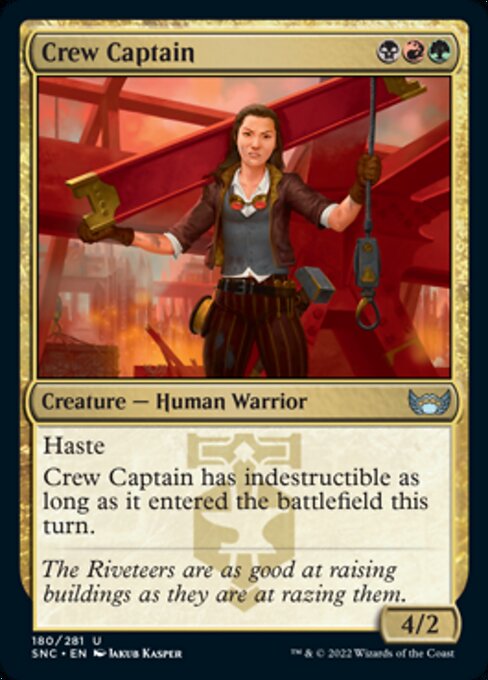
The Riveteers’ uncommon legend, Mr. Orfeo, the Boulder is another card that rewards attacking. A 2/4 body isn’t exactly a powerhouse, however, its ability to double the power of an attacking creature will make this card a real threat. Great with tramplers, or flying threats, Mr. Orfeo can also target himself, effectively attacking as a 4/4.
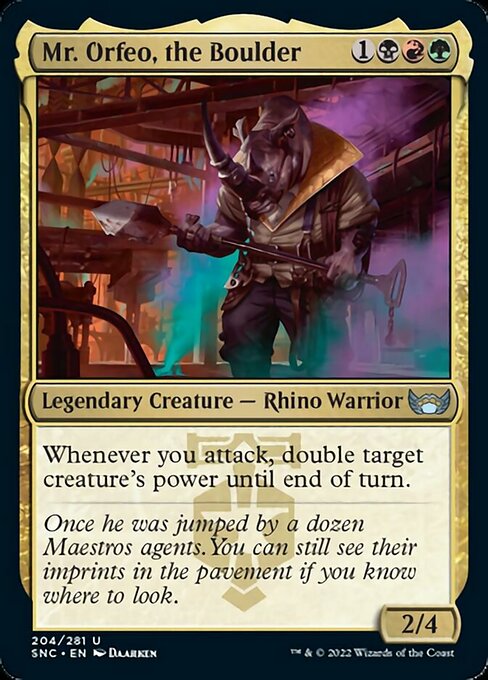
Forcing your opponent to sacrifice their best creature is likely to be the main use of Riveteers Charm, however the buyout clause of a pseudo draw three is nice to have. Whilst exiling the graveyard won't be worth a card in most matchups, in some games, versus Dimir or Maestro this option may be worth its weight in gold.
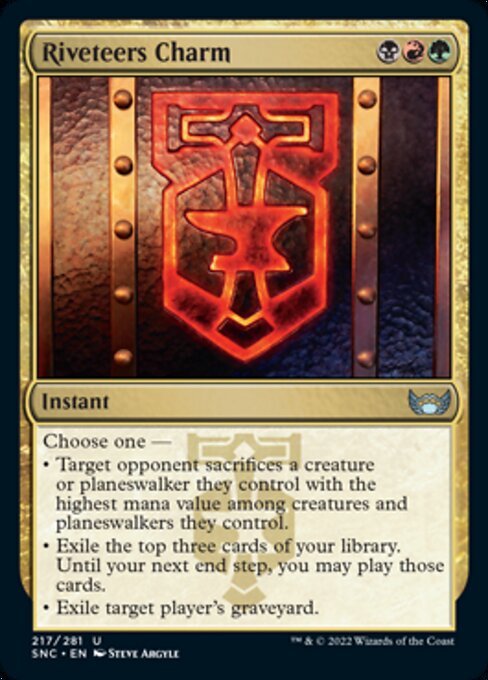
Ziatora’s Envoy is a Riveteer powerhouse available at rare. Able to draw you a card whenever it hits the opponent (and often putting it directly into play), there sure is a ton of value to be had here. Four toughness is also nice, given the high number of spells in the set which deal three damage.
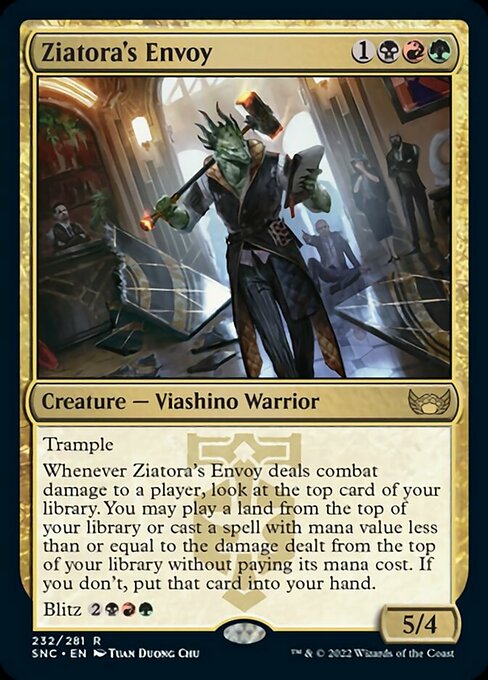
Another uncommon payoff for this deck, which we couldn’t help mentioning is the Pyre-Sledge Arsonist. Whilst Rakdos decks will be looking to snap this up, it may be even stronger in Riveteers, due to the additional amount of treasure available in this shard.
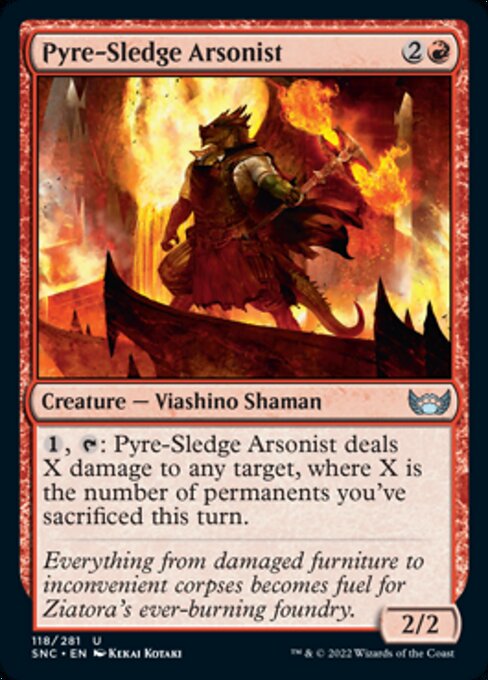
Dave ‘Angri’ Warner
Angri started playing Magic The Gathering during the Ice Age expansion. Proud to have collected a full set of 4th Edition, he was horrified to discover that, whilst he was away at college, his mom had donated his cards to a thrift store! With two mathematics degrees safely under his belt, Angri turned his attention to the world of online poker. Following a 10 year stint as a professional poker player, he finally returned to the glorious game of his youth. When not found playing or writing about MTG, he enjoys hanging out with his small family or riding an electric bike around the polluted English city he calls home.
